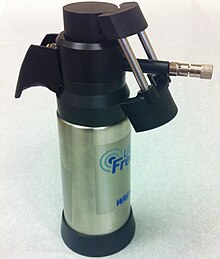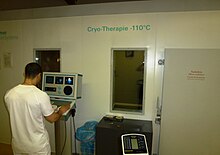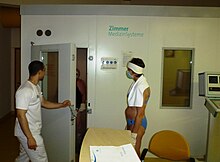Cryotherapy: Difference between revisions
InedibleHulk (talk | contribs) m →Adverse effects: Not everything a coroner says is pronouncing. |
Dino monster (talk | contribs) →Adverse effects: added claim about underreporting adverse events in literature |
||
| Line 41: | Line 41: | ||
In October 2015, an accident at a Nevada cryotherapy center led to the death of a worker in a full-body cryotherapy chamber, which contained air at below freezing temperatures. Chelsea Ake-Salvacion was found dead in one of the center's tanks, having entered it at the end of the previous working day. The coroner said Ake-Salvacion died within minutes.<ref>http://www.nytimes.com/2015/10/27/us/death-of-woman-in-tank-at-a-nevada-cryotherapy-center-raises-questions-about-safety.html?_r=0</ref> |
In October 2015, an accident at a Nevada cryotherapy center led to the death of a worker in a full-body cryotherapy chamber, which contained air at below freezing temperatures. Chelsea Ake-Salvacion was found dead in one of the center's tanks, having entered it at the end of the previous working day. The coroner said Ake-Salvacion died within minutes.<ref>http://www.nytimes.com/2015/10/27/us/death-of-woman-in-tank-at-a-nevada-cryotherapy-center-raises-questions-about-safety.html?_r=0</ref> |
||
Systematic reviews of whole-body cryotherapy have repeatedly called for research studies to implement active surveillance of adverse events, which are suspected of being underreported.<ref name=":0"/><ref name=Bleakley-2014>{{cite journal|last1=Bleakley|first1=Chris|last2=Bieuzen|first2=Francois|last3=Davison|first3=Gareth|last4=Costello|first4=Joseph|title=Whole-body cryotherapy: empirical evidence and theoretical perspectives|journal=Open Access Journal of Sports Medicine|date=March 2014|pages=25|doi=10.2147/OAJSM.S41655}}</ref> |
|||
==Cryotherapy and headaches== |
==Cryotherapy and headaches== |
||
Revision as of 09:02, 30 October 2015
Cryotherapy is the local or general use of low temperatures in medical therapy. Cryotherapy is used to treat a variety of benign and malignant tissue damage, medically called lesions.[1] The term "cryotherapy" comes from the Greek cryo (κρύο) meaning cold, and therapy (θεραπεία) meaning cure. Cryotherapy has been used as early as the seventeenth century.
Its goal is to decrease cell growth and reproduction (cellular metabolism), increase cellular survival, decrease inflammation, decrease pain and spasm, promote the constriction of blood vessels (vasoconstriction), and when using extreme temperatures, to destroy cells by crystallizing the cytosol, which is the liquid found inside cells, also known as intracellular fluid (ICF). The most prominent use of the term refers to the surgical treatment, specifically known as cryosurgery. Other therapies that use the term are whole-body cryotherapy[2] and ice pack therapy.
Hyperbaric gaseous cryotherapy
In 1993, Christian Cluzeau developed the hyperbaric gaseous cryotherapy also called NeuroCryoStimulation or NCS that can immediately relieve pain by acting on four physiological effects:[3][4]
- Painkiller
- Vasomotor
- Anti-inflammatory
- Muscle relaxation
This technique, practiced by some doctors, physiotherapists and veterinarians consists in applying for a short time on the skin up to the painful area, carbon dioxide at −78 °C with a pressure of 50 bars and a frequency of 400 Hz. Sessions can be repeated at will. Unlike ice packs, the usage of carbon dioxide does not produce pain. Even if not as dangerous as liquid nitrogen used in cryosurgery, the low temperature could cause burns.
Cryosurgery

Cryosurgery is the application of extreme cold to destroy abnormal or diseased tissue. Cryotherapy is used to treat a number of diseases and disorders, most especially skin conditions like warts, moles, skin tags and solar keratoses. Liquid nitrogen is usually used to freeze the tissues at the cellular level. The procedure is used often because of its efficacy and a low rate of side effects.
Ice pack therapy
Ice pack therapy is a treatment of cold temperatures to an injured area of the body. An ice pack is placed over an injured area and is intended to absorb heat of a closed traumatic or edematous injury by using conduction to transfer thermal energy. The physiologic effects of cold application include immediate vasoconstriction with reflexive vasodilation, decreased local metabolism and enzymatic activity, and decreased oxygen demand. Cold decreases muscle spindle fiber activity and slows nerve conduction velocity, therefore it is often used to decrease spasticity and muscle guarding. It is commonly used to alleviate the pain of minor injuries, as well as decrease muscle soreness. The use of ice packs in treatment decreases the blood flow most rapidly at the beginning of the cooling period,[5] this occurs as a result of vasoconstriction, the initial reflex sympathetic activity. As stated previously, ice is a very popular modality for treatment in injuries and muscle repair following any activity, however the application of cold prior to activity is also an option, and is often used in sports medicine.
Ice is not commonly used prior to rehabilitation or performance because of its known adverse effects to performance such as decreased myo-static reflex and force production, as well as a decrease in balance immediately following ice pack therapy for 20 minutes.[6] However, if ice pack therapy is applied for less than 10 minutes, performance can occur without detrimental effects. The physiological effects that the body goes through after cold therapy application include initial vasoconstriction, shunting all blood away from the body part, followed by vasodilation, as blood flows back to the affected area in attempt to re-warm. If the ice bag therapy is removed at this time, sportsmen are sent back to training or competition directly with no decrease in performance.[7]
Whole body cryotherapy



Whole body cryotherapy (WBC) is offered by clinicians as an alternative to cold water immersion or ice packs.[2] This treatment involves exposing individuals to extremely cold dry air (below -100 °C) for two to four minutes. To achieve the subzero temperatures required for WBC, two methods are typically used: liquid nitrogen and refrigerated cold air. During these exposures, individuals wear minimal clothing, which usually consists of shorts for males and shorts and a crop top for females. Gloves, a woollen headband covering the ears, and a nose and mouth mask, in addition to dry shoes and socks, are commonly worn to reduce the risk of cold-related injury. The first WBC chamber was built in Japan in the late 1970s, but WBC was not introduced to Europe until the 1980s, and has only been used in the USA and Australia in the past decade.[2]
Whole body cryotherapy was initially intended for use in a clinical setting to treat patients with conditions such as multiple sclerosis and rheumatoid arthritis;[8][9] however, elite athletes have recently reported using the treatment to alleviate delayed onset muscle soreness (DOMS) after exercise.[10][11][12][13] Recently, recreational athletes have started to emulate elite athletes in using these treatments after exercise. Reductions in muscle[14] and skin[14][15] tissue temperature after WBC exposure may stimulate cutaneous receptors and excite the sympathetic adrenergic fibres, causing constriction of local arterioles and venules.[14][16] Consequently, WBC may be effective in relieving soreness, or muscle pain, through reduced muscle metabolism, skin microcirculation, receptor sensitivity and nerve conduction velocity.[2] Interestingly, a paradoxical increase in rectal temperature, followed by a slight decline, has been reported following exposure to the treatment.[14] The is also a body of evidence to suggest that WBC stimulates the autonomic nervous system (ANS), with a predominance of parasympathetic tone activation, after exposure.[17]
WBC is commonly employed shortly (within 0 to 24 hours) after exercise, and the treatment is often repeated on the same day[10] or over several days.[18] In the field of athletic training, a new method of exposing people to these extreme temperatures, called partial-body cryotherapy (PBC), using a portable cryo-cabin, has recently been developed.[17] This system has an open tank and exposes the body, except the head and neck, to temperatures below -100 °C.
Evidence from a recent Cochrane review[2] suggests that there is insufficient evidence to determine whether whole-body cryotherapy reduces self-reported muscle soreness, or improves subjective recovery, after exercise compared with passive rest or no whole-body cryotherapy in physically active young adult males.[13]
Adverse effects
In October 2015, an accident at a Nevada cryotherapy center led to the death of a worker in a full-body cryotherapy chamber, which contained air at below freezing temperatures. Chelsea Ake-Salvacion was found dead in one of the center's tanks, having entered it at the end of the previous working day. The coroner said Ake-Salvacion died within minutes.[19]
Systematic reviews of whole-body cryotherapy have repeatedly called for research studies to implement active surveillance of adverse events, which are suspected of being underreported.[2][20]
Cryotherapy and headaches
A study published in the September 2000 edition of the Archives of Family Medicine showed that a combination of pressure and cold temperatures can successfully mitigate headache-related pain and also decrease the duration of a headache.[21] Eighty-seven percent of participants (p=.004) said that the combination of pressure as well as temperature therapy was "optimally effective"; 13% said that the temperature therapy was "moderately effective".[21]
Many products exist that provide temperature therapy, many times cryotherapy is used to combat headaches.[citation needed]
See also
References
- ^ Cryotherapy at eMedicine
- ^ a b c d e f Costello, Joseph T.; Baker, Philip Ra; Minett, Geoffrey M.; Bieuzen, Francois; Stewart, Ian B.; Bleakley, Chris (18 September 2015). "Whole-body cryotherapy (extreme cold air exposure) for preventing and treating muscle soreness after exercise in adults". The Cochrane Database of Systematic Reviews. 9: CD010789. doi:10.1002/14651858.CD010789.pub2. ISSN 1469-493X. PMID 26383887.
- ^ Cluzeau, Christian and Mourot, Laurent (2010) La Cryotherapie Gazeuse Hyperbare Ou Neurocryostimulation. Editions Universitaires Europeennes. ISBN 6131525455[page needed]
- ^ Company overview. cryonic-medical.com
- ^ Swenson, C; Sward, L; Karlsson, J (1996). "Cryotherapy in Sports Medicine". Scandinavain Journal of Medicine and Science in Sports. 6 (4): 193–200. doi:10.1111/j.1600-0838.1996.tb00090.x. PMID 8896090.
- ^ Cross, K.M.; Wilson, R.W.; Perrin, D.H. (1996). "Functional Performance Following an Ice Immersion to the Lower Extremity". Journal of Athletic Training. 31 (2): 113–6. PMC 1318440. PMID 16558383.
- ^ Saam, F.; Seidinger, B; Tibesku, C. O. (2008). "The Influence of Cryotherapy of the Ankle on Static Balance". Sportverletz Sportschaden. 22 (1): 45–51. doi:10.1055/s-2007-963601. PMID 18350484.
- ^ Metzger, D.; Zwingmann, C.; Protz, W.; Jäckel, W. H. (1 April 2000). "[Whole-body cryotherapy in rehabilitation of patients with rheumatoid diseases--pilot study]". Die Rehabilitation. 39 (2): 93–100. doi:10.1055/s-2000-14442. ISSN 0034-3536. PMID 10832164.
- ^ Hirvonen, H. E.; Mikkelsson, M. K.; Kautiainen, H.; Pohjolainen, T. H.; Leirisalo-Repo, M. (1 June 2006). "Effectiveness of different cryotherapies on pain and disease activity in active rheumatoid arthritis. A randomised single blinded controlled trial". Clinical and Experimental Rheumatology. 24 (3): 295–301. ISSN 0392-856X. PMID 16870097.
- ^ a b Costello, J. T.; Algar, L. A.; Donnelly, A. E. (1 April 2012). "Effects of whole-body cryotherapy (-110 °C) on proprioception and indices of muscle damage". Scandinavian Journal of Medicine & Science in Sports. 22 (2): 190–198. doi:10.1111/j.1600-0838.2011.01292.x. ISSN 1600-0838. PMID 21477164.
- ^ Hausswirth, Christophe; Louis, Julien; Bieuzen, François; Pournot, Hervé; Fournier, Jean; Filliard, Jean-Robert; Brisswalter, Jeanick (1 January 2011). "Effects of whole-body cryotherapy vs. far-infrared vs. passive modalities on recovery from exercise-induced muscle damage in highly-trained runners". PloS One. 6 (12): e27749. doi:10.1371/journal.pone.0027749. ISSN 1932-6203. PMC 3233540. PMID 22163272.
{{cite journal}}: CS1 maint: unflagged free DOI (link) - ^ Pournot, Hervé; Bieuzen, François; Louis, Julien; Mounier, Rémi; Fillard, Jean-Robert; Barbiche, Etienne; Hausswirth, Christophe (1 January 2011). "Time-course of changes in inflammatory response after whole-body cryotherapy multi exposures following severe exercise". PloS One. 6 (7): e22748. doi:10.1371/journal.pone.0022748. ISSN 1932-6203. PMC 3145670. PMID 21829501.
{{cite journal}}: CS1 maint: unflagged free DOI (link) - ^ a b Roberts, Michelle (29 September 2015). "Should Welsh rugby team ditch the big freeze?". BBC News. BBC. Retrieved 29 September 2015.
- ^ a b c d Costello, Joseph Thomas; Culligan, Kevin; Selfe, James; Donnelly, Alan Edward (6 November 2012). "Muscle, Skin and Core Temperature after −110°C Cold Air and 8°C Water Treatment". PLoS ONE. 7 (11): e48190. doi:10.1371/journal.pone.0048190. PMC 3491015. PMID 23139763.
{{cite journal}}: CS1 maint: unflagged free DOI (link) - ^ Costello, J. T.; Donnelly, A. E.; Karki, A.; Selfe, J. (1 January 2014). "Effects of whole body cryotherapy and cold water immersion on knee skin temperature". International Journal of Sports Medicine. 35 (1): 35–40. doi:10.1055/s-0033-1343410. ISSN 1439-3964. PMID 23780900.
- ^ Savic, Miroslav; Fonda, Borut; Sarabon, Nejc (1 May 2013). "Actual temperature during and thermal response after whole-body cryotherapy in cryo-cabin". Journal of Thermal Biology. 38 (4): 186–191. doi:10.1016/j.jtherbio.2013.02.004.
- ^ a b Hausswirth, Christophe; Schaal, Karine; Le Meur, Yann; Bieuzen, François; Filliard, Jean-Robert; Volondat, Marielle; Louis, Julien (1 January 2013). "Parasympathetic activity and blood catecholamine responses following a single partial-body cryostimulation and a whole-body cryostimulation". PloS One. 8 (8): e72658. doi:10.1371/journal.pone.0072658. ISSN 1932-6203. PMC 3749989. PMID 23991134.
{{cite journal}}: CS1 maint: unflagged free DOI (link) - ^ Lubkowska, Anna; Dołęgowska, Barbara; Szyguła, Zbigniew (1 January 2012). "Whole-body cryostimulation--potential beneficial treatment for improving antioxidant capacity in healthy men--significance of the number of sessions". PloS One. 7 (10): e46352. doi:10.1371/journal.pone.0046352. ISSN 1932-6203. PMC 3471883. PMID 23077506.
{{cite journal}}: CS1 maint: unflagged free DOI (link) - ^ http://www.nytimes.com/2015/10/27/us/death-of-woman-in-tank-at-a-nevada-cryotherapy-center-raises-questions-about-safety.html?_r=0
- ^ Bleakley, Chris; Bieuzen, Francois; Davison, Gareth; Costello, Joseph (March 2014). "Whole-body cryotherapy: empirical evidence and theoretical perspectives". Open Access Journal of Sports Medicine: 25. doi:10.2147/OAJSM.S41655.
{{cite journal}}: CS1 maint: unflagged free DOI (link) - ^ a b Landy, Stephen H.; Griffin, Brand (2000). "Pressure, heat, and cold help relieve headache pain". Archives of Family Medicine. 9 (9): 792–3. PMID 11031383.
External links
- Cryotherapy at the U.S. National Library of Medicine Medical Subject Headings (MeSH)
- A training course in Cryotherapy (IARC Screening Group)
- Rugby World Cup 2011: How cryotherapy chamber allowed Wales to come in from the cold
